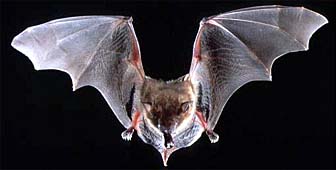Bat lovers sing the virtues of a maligned mammal

Conservationists throughout Switzerland launched their annual public relations campaign on behalf of the much-maligned bat on Friday night. Bat Night was an attempt to persuade people that the world's only flying mammal is a cute little creature in need of protection.
“These are lovely little animals, not blood-sucking vampires,” says Volker Mahnert, director of Geneva’s Natural History Museum, home of the Swiss Bat Centre.
“Hardly anyone has ever seen one of them close up. We want people to get to know them and walk away a positive image,” he told swissinfo.
The fifth edition of Bat Night in Switzerland was of particular importance since it coincided with the International Year of the Bat – the tenth anniversary of the signing of the Agreement on the Conservation of Bats in Europe, also known as EUROBATS.
Bats may have won the support of governments, but Mahnert says it’s more difficult, and more important, that they find favour among the public, too. “Protection is only possible if you get the public on board,” Mahnert says. “This is especially true of bats, which often live in close proximity to man.”
Bats make up nearly a quarter of all the world’s 4,500 mammal species, yet, partly because of their secretive nocturnal habits, relatively little is known about them. It comes as a surprise to many to learn that there are no fewer than 27 species of bat in Switzerland – and that some might be sharing their home.
“They are difficult to observe. We are still learning new things about them, so it’s exciting scientifically, but also because they are really cute little creatures,” says Manuel Ruedi, a scientist at the Bat Centre, who has studied these animals for 20 years.
Many of the larger bats in Switzerland are under threat, as they feed on the larger insects, which have been reduced in numbers as a result of pesticides and intensive agriculture.
Some, such as the common pipistrelle, which adapts well to life in urban areas, are more abundant, but still in need of protection. The situation of other bat species is not known since they are rarely sighted.
“All of the bats that live in Switzerland are insect-eating and therefore all of them are at risk from pesticides,” says Mahnert. It is often said that bats are one of the best environmental indicators, since they thrive best when the ecosystem is healthy and stable.
Bat Night in Switzerland coincided with similar events all over Europe, and the need for such public awareness campaigns is clear: while bats have few natural enemies, they are among the animals that have suffered most from human activities.
The event also provided a chance to explode a few of the myths surrounding these fascinating creatures: they are definitely not birds; they are not related to mice, nor do they breed like them; and those found in Europe do not drink blood.
Bats will make their homes virtually anywhere. Some species prefer to live in caves or trees. On the Bat Night tour, participants had the chance to see bats living in a school, on the banks of a river, in a castle and on an industrial estate.
Abandoned buildings provide excellent roosts for large colonies of bats. Some abandoned churches have been found to contain up to 1,000 animals.
A large number of bats choose to find shelter under the roofs of people’s homes. Once they would have been regarded as unwanted intruders, but increasingly they are being welcomed.
“Attitudes have changed. The general public is beginning to realise that bats are not diabolical creatures,” Manuel Ruedi says.
“Now four out of five people are prepared to put up with a little inconvenience and keep the bats in their home, and that’s important because they can play a direct role in protecting them and their roosts,” he told swissinfo.
The Swiss Bat Centre, which began work 15 years ago, provides advice and practical help for those people who find bats roosting in their homes. This could simply be a matter of ensuring that old trees are not cut down, or that a small aperture is always left to allow bats to leave and enter a house.
There are two main centres for Bat protection in Switzerland, in Geneva and Zurich. Funded by the federal and cantonal governments, they not only conduct scientific studies on bats and their habitats, but have also built up a network of local and regional volunteers, which has served as a model for bat protection groups in other European countries.
by Roy Probert

In compliance with the JTI standards
More: SWI swissinfo.ch certified by the Journalism Trust Initiative
You can find an overview of ongoing debates with our journalists here . Please join us!
If you want to start a conversation about a topic raised in this article or want to report factual errors, email us at english@swissinfo.ch.